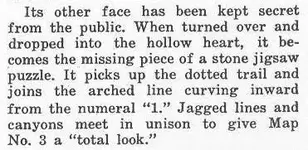Re: The "Peralta" Stone Maps --- On Their Own
I made several posts in the "Tumlinson Profile" topic, about the color of the Heart Stone, as reported in the April-May, 1973,
Frontier Times article, by Bernice and Jack McGee.
I'm not sure that my posts about the McGees article belonged in that topic, but it kind of relates to the possibility that Travis made the Stone Maps, so I'm posting this extension of it here.
I got to looking at the side view of the Heart Stone posted there, and thought that an analysis of it's own probable timeline would be interesting, and possibly revealing of something further clues.
Here is the photo I'm referring to, taken by Joe R. (cactusjumper), where the Stone Maps are on display---
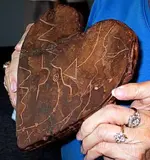
While the McGee's story twice refers to the Heart Stone as a "yellowish rock," the Heart on display, as can be seen in the photo above, appears to be a reddish dark brown. I got to wondering how this could be resolved.
The grooves in the markings certainly do look "yellowish." So it appears that the stone material, itself, is indeed composed of yellowish rock of some kind.
The article also says "slate-type rock." Due to the apparent layering, as seen on the side of the Heart, it does seem that this description is realistic, too.
But I find it problematic that, merely because the color in the grooves reveal the natural yellow color of the stone inside, that the authors would describe the
looks of it merely as "yellowish rock." Seeing as there are no color photographs included in the article, if any description would be given under that circumstance, it would be much more
complete, regarding the appearance of it, to state the overall obvious color of the surface, plus note the color of the inside of it as indicated by the line marking grooves. As it stands, the story gives the impression that the Heart they saw was yellowish all over, due to the
three different statements to that effect.
I would describe it as made from a yellowish rock which was a reddish dark brown on the outside.
Or as reddish dark brown rock, with yellowish line marking grooves. Because it's overall appearance is the reddish dark brown, and only upon close inspection can it be seen that the lighter coloring, of the grooves of the markings, is because the outer stain was penetrated by whatever tool was used to carve the lines.
But regardless of how it is described, there is an interesting sequence of events which must have taken place in the creation of the Heart Stone, by whoever made it. This sequence may shed some light on possible theories about who made it, and under what circumstances (as possible conditions during the making of the Stones are suggested by the McGees, in their article referenced above).
First, considering the very dark coloring of the surface of the Heart Stone. How did that get there?
Is it a natural patina, darkened over time?
If it were a natural patina, with the yellow underneath exposed, when the marking lines were carved,
then why aren't the sides of the Heart yellow also? Unless the heart was found
naturally in that heart-shape, it had to have been carved to shape it that way, right? If the marking lines were carved
before it got patinaed, the line grooves would also be dark.
I know that skin oil, from handling, can darken stone, like the well known effect on turquoise, but not this dark, and not this consistant, all over the surface of a piece the size of the Heart.
If it was a naturally patinaed slab, the sides would be yellow. So it was
stained at some point
before it was carved.
Either that, or it was carved into a heart shape
long before the line markings were grooved into it. If this were the case, then the Stone Trail maps would have to have been sized to fit the (much older) Heart.
An interesting thing about the darker surface of the Heart, is that it is darkened
on both sides. Was it carved into a heart, then set out, laying out in the weather for a very long time,
then turned over, like a pancake, to patina the flip side? For what purpose? What are the odds of that?
It seems like a conclusion can be made that the Heart Stone in the photo above, was first carved into a heart shape, then stained somehow, then the line markings were grooved into it.
But wait! There's more! 8)
What about those breaks? And the glue?
Some of the marking lines pass through the breaks. It looks like the glue is a dark color, even darker than the stain. But since the yellow in the marking grooves
doesn't show yellow where the glue was applied, it must have had the line marking grooves carved
before it was glued. Also, none of the yellow of the inside of the stone shows where the breaks are glued, so the glue was smeared in such a way that it, intentionally or not, eliminated any yellow showing through.
So, from all that above, the apparent Heart making sequence (disregarding the carved-heart-aged-patina-stone-flipping scenario)---
1. Some slate-type rock was gotten from somewhere, either at the correct thickness or trimmed to the existing thickness.
2. The Heart shape was carved from this slab.
3. The Heart was somehow stained a reddish dark brown, on both sides, and all around the edges.
4. The line marking grooves were carved into the Heart, leaving the grooves yellowish.
5. The Heart Stone was
carefully broken, in
two places, with the breaks crossing each other.
6. The breaks were glued, using some kind of dark glue.
7. The Stone Maps were "discovered" by Travis Tumlinson (or he discovered the first one, the Priest/Horse Stone, and
made the Trail and Heart Stones) or whatever version of how he came to have them, that you prefer!
For number five, above, it doesn't really seem possible that the breaks were accidental. There would be chips on the Heart Stone, most probably on the edges, if it was broken from a fall. It seems improbable that the two breaks, in different directions would occur together, and be so symmetrically placed. Although there appear to be some dents around the edge of the Heart in the photo, any chips would show yellowish stone, as the line marking grooves do.
At point number five in the sequence, is the only time that the breaks could have taken place, due to the observations listed previously in this post.
If the Heart Stone was, indeed,
intentionally broken, then those breaks were intended to
mean something.
If the Heart Stone was
artificially patinaed, then what are the possible ways of doing that? I mean, if someone used a stain from the local hardware store, it would surely be readily detectable, right? People do artificially patina brass objects and coins, so is there a way to do it to rocks? Like roasting in the oven or something? Or applying some chemical which will then evaporate or change to something which is naturally found on patinaed rock?

All-in-all, the sequence of manufacture tells something. It tells that the making of the Heart Stone, shown in the Photo, was far more complex than making the Trail Stones or Horse/Priest Stones. Now the question would be, "Why go to so much trouble for that one stone?"
Another question would be, "Why did the McGees leave their description as simply 'a yellowish stone'?" And, right after stating that color, why did they add the word "reportedly" in the sentence, "Reportedly cut from a slab of red chalcedony" (were they indicating a possible contradiction with their own observation of the Heart?)
And of course, the question of, why the McGees' drawing of the Heart Stone line markings, is drastically different than the display Heart Stone, when all of the other of their Stone Maps drawings are essentially the same as the ones on display?
And finally, that lingering question that just won't go away: What is that confounding "needle," which matches the Needle on that copy of Julia's map, doing on the Heart Stone in the photo?

reference photos---
Back side of the display Heart Stone
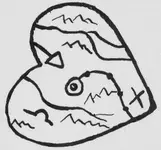
Heart Map drawing from McGees' article Heart Stone on display
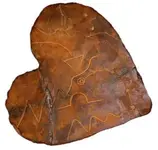
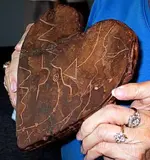
(I know, I said I was done talking about the McGees' "Yellow Heart Stone," but this adds more about the Heart on display, namely the sequence of manufacture.) 8)






















